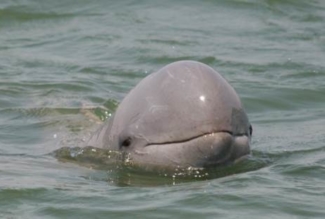


This research confirms the need to expand monitoring to new areas where high-impact fisheries and other human activities operate. Importantly, findings show the majority of areas with highest habitat suitability are not currently surveyed for dolphins and located outside Kep’s Marine Fisheries Management Area.

Models with highest variable importance scores were water depth, pre- and during monsoon season (61–62%), and sea surface temperature, post-monsoon (71%), which suggests that greater freshwater flow during the wet season may alter primary productivity and dolphin prey abundance. Four predictor sets, each with a unique combination of variables, were used to map seasonal variation in dolphin habitat suitability. With respect to seasonality, statistical tests detected significant differences for all environment variables considered except seafloor slope. Overall, Irrawaddy dolphins of Kep displayed habitat preferences similar to other populations, and were predominately encountered in three situations: (1) water depths ranging from 3.0 to 5.3 m, (2) surface water temperatures of 27–32☌, and (3) in close proximity to offshore islands (< 7.5 km). Leveraging two years of species and oceanographic data-depth, slope, distance to shore and rivers, sea surface temperature, and chlorophyll-a concentration-we built temporally stratified models to estimate distribution and infer seasonal habitat importance. Here, we test the hypothesis that accurate seasonal habitat models, relying on environmental data and species occurrences alone, can be used to describe the ecological processes governing abundance for the resident dolphin population of the Kep Archipelago, Cambodia. Understanding habitat preferences and distribution aids in the identification of areas to target for monitoring and conservation, which is particularly challenging in data-limited nations of Southeast Asia. In 2019, the area was recognized as an Important Marine Mammal Area, largely owing to the significant presence of Irrawaddy dolphins ( Orcaella brevirostris).

1CRETUS-Department of Applied Economics, University of Santiago de Compostela, Santiago de Compostela, Spain.Clark 4, Peter Walker 4 and Oliver Clements 4 Meanwhile, required funds were raised from selling dolphin-branded merchandise and the proceeds were used to support the local fishing communities, fighting for the survival of the dolphins.Gregory M. Signatures from nature lovers were collected and a petition is submitted to the State Counsellor of Myanmar to increase the level of protection given to the freshwater ecosystems and to apply "Cooperative Fishing" culture as an "Intangible Cultural Heritage" under the UNESCO convention. In response to the record-high killing of the endangered dolphins by electric fishermen, a public campaign was launched to raise awareness about the importance of this flagship species. Historical records show that these intelligent dolphins from upper Ayeyarwady river are the only population of Irrawaddy dolphins to help local fishermen to increase their catch by engaging in "C ooperative F ishing", a unique and valuable cultural heritage practiced by local fishing communities along the river for centuries. Rampant electrofishing, pollution, entanglement in fishing nets, and habitat destruction are threatening the long term survivals of these rare dolphins in Myanmar. The last census counted only about 70 individuals. The lovely Irrawaddy Dolphin sub- population living in the Ayeyarwady river is critically endangered.


 0 kommentar(er)
0 kommentar(er)
